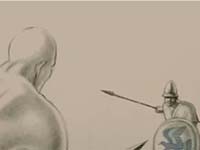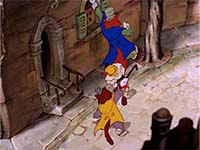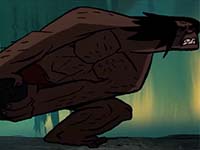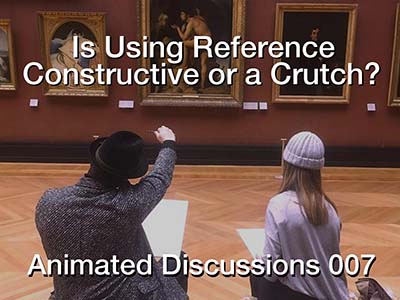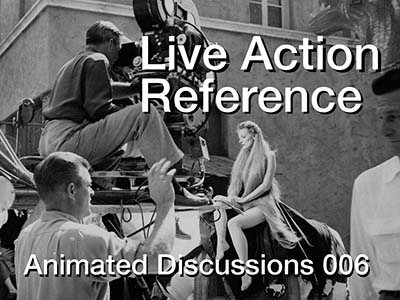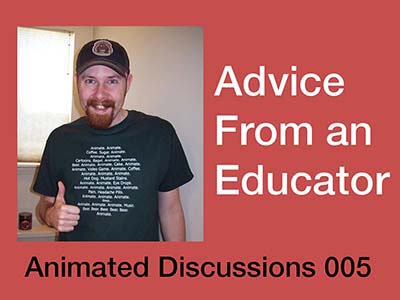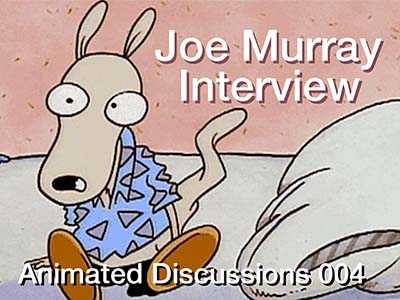People who aren’t members of Animation Resources don’t understand how comprehensive our Reference Packs are. This week, we will be posting what each section of our current RefPack looks like, starting today with the Featured section. If you are a member of Animation Resources, click on this post to go to the Members Only page. If you aren’t a member yet, today is the perfect time to join! Our current Reference Pack is our biggest yet, and General and Student Members get access to a special Bonus Archive with even more material from past Reference Packs.
What are you waiting for?![]()
JOIN TODAY!
https://animationresources.org/membership/levels/

As a special thank you to our annual General and Student members, we have created a special page where we will archive past Reference Packs. There will be at least three reruns of complete RefPacks per year.
If you are currently on a quarterly membership plan, consider upgrading to an annual membership to get access to our bonus page with even more downloads. If you still have time on you quarterly membership when you upgrade to an annual membership, email us at…
membership@animationresources.org
…and we will credit your membership with the additional time.
Available to Student and General Members
Eugene "Zim" Zimmerman![]()
Zim’s Correspondence School of Cartooning, Comic Art & Caricature Volume 1, 2, 3 & 4: Books 1 to 20 (1914/1920)
Download this article
Zim’s Correspondence School of Cartooning, Comic Art and Caricature consists of twenty 32-page books packed with artwork, practical advice, homespun philosophy, and plain old horse sense. Every month a new book would arrive in the mail, and the student would be responsible for arranging to ship their completed assignments to Horseheads, NY where Zim would review and critique them for a small fee. These books are among the rarest and most sought after cartooning instruction books in existence.
These four PDF e-book contain all 20 lesson books compiled from both the 1914 and 1920 editions of the Zim course, and includes a foreword by Ralph Bakshi, an introduction by Stephen Worth and a detailed biography of Eugene Zimmerman. The lesson books are supplemented with full page color illustrations by Zim taken from issues of Judge’s Library magazines from the 1890s.
Click to access the…
Downloads expire after February 2022
But that’s not all… We don’t want to forget our quarterly members. As a teaser to convince you to upgrade to an annual membership, here is another book by Eugene Zimmerman. Download it and take a look at it. We think this little book will inspire you to become an annual member and download the full four volume Zim course.
PDF E-BOOK:
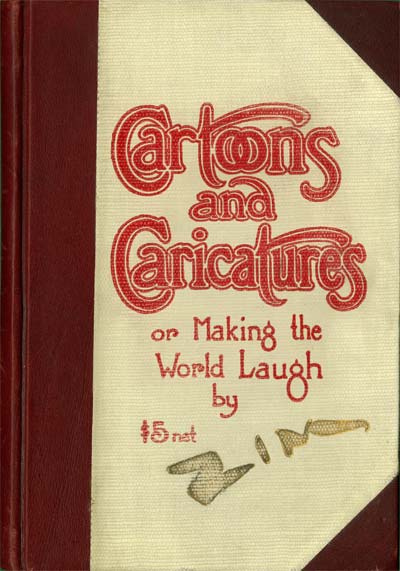
Eugene "Zim" Zimmerman![]()
Zim’s Cartoons & Caricatures, Or Making The World Laugh (1910)
For years Animation Resources had been searching high and low for a copy of Zim’s earliest educational materials with no luck. But recently this 1910 book, packed with tips for the aspiring cartoonist, turned up in a used bookstore in Arizona. This was Eugene Zimmerman’s first “how to” book on cartooning. It’s worth noting that the price tag on the cover is an important clue to the value of these lessons to contemporary artists. According to the Consumer Price Index, $5 in 1910 is equivalent to $116 today. Five dollars represented a full day’s labor to many of the cartoonists who bought this book. Zim’s name in gold letters on the cover was the selling point that made so many aspiring cartoonists part with the “five plunks (in real Money)” as Zim so colorfully puts it in his introduction.
At the time this book was written, Zim had thirty years of experience under his belt, and had attained the highest level in his field. The book sold very well, but the publisher was a crook and disappeared with all of the profits. His creditors tracked him down and took him to court. Zim testified against the publisher at the trial and learned of how much money was made, and how little of it was paid to him and the suppliers of the company. He came to the realization that if a crook could make that much money off of his book, he should write one of his own and make the money himself. He set to work on a series of books that became the greatest course in cartooning of its day.
Adobe PDF File / 112 Pages / 119 MB Download

One of the most popular features of Animation Resources’ social media accounts is our breakdown clips. We will be sharing a batch of them with you in each Reference Pack, so you can download them and build your own library of breakdowns. Organize them into folders by subject, like "walk cycles" or "takes" and refer to them when you need inspiration in your own animation.
SD VIDEO:

Perspective Turns![]()
Curated By David Eisman
Download this article
Arguably the most difficult, arduous, and torturous technique in all of animation is the Perspective Turn. In order to craft the illusion of a simulated camera move, a foreground figure must be rotated in one direction while a reference point— be it a figure or background— is rotated in the opposite direction. While the technique can be achieved with a limited number of frames, a high frame count is often necessary to avoid strobing and create fluid motion. However, the greater the number of frames, the tighter the difference in degrees for the individual inbetweens. The number of frames for any given Perspective Turn can be calculated by identifying the arc length of the Turn as well as the desired degree difference per inbetween.
Suppose the animator is attempting to craft a Perspective Turn on 1s that travels a full 180 degrees, starting at the front of the figure and ending at the back. Additionally, this animator plans to maintain an approximate inbetween degree difference of 2. Therefore, in order to animate such a Perspective Turn, the animator would have to draw 90 separate frames wherein each inbetween the figure is rotated by 2 degrees.
In truth, while such a perspective turn would certainly be astounding and impressive to other animators, it would barely register to the typical audience. The average viewer witnesses camera moves in live-action and 3D animation regularly. The audience doesn’t realize how much work went into mimicking fluid live-action camera work. Regardless of viewer interest, the Perspective Turn is still an impressive and interesting technique worthy of study and analysis.

Breakdown 03 showcases a 270 degree Perspective Turn with 85 frames. The simulated camera begins at side profile and ends at the front view of the foreground figure. This particular Perspective Turn is quite impressive as the reference point is not a background but another figure which is rotating in the opposite direction of the main figure. Calculating the approximate inbetween degree difference is difficult as the spacing is not even. While the first 64 frames are on 1s, the following 20 frames are on 2s. Since the first 64 frames constitute the initial 180 degree turn, the average approximate inbetween degree difference would be 3. However, the spacing on this particular turn is not even, so the exact inbetween degree difference may differ wildly from the calculated average. Since the final 90 degree turn is animated on 2s, the approximate degree difference would be 9 instead of 4.5. It is important to note that the manual truck in for Breakdown 03 carries the latter third of the Perspective Turn after the second figure is no longer visible.
Even though this particular Perspective Turn is fluid, the stillness of the characters detracts from the effect. Animating such a tight Perspective Turn around moving characters would have made the technique exponentially more difficult to achieve. However, without movement, the characters feel lifeless. The slick camera move only reinforces the unnatural stillness of the figures. Also, it is important to realize that throughout the entirety of the Perspective Turn in Breakdown 03, the feet of both figures are hidden. In such tight Perspective turns, it is virtually impossible to track the feet and maintain their proper connection to the ground. If the feet were shown, they would most likely skate.
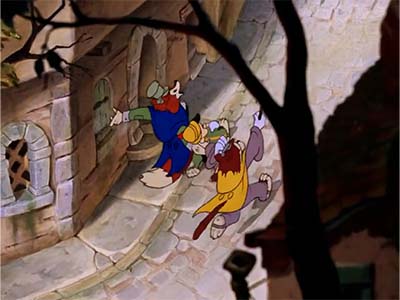
Breakdown 05 achieves a Perspective Turn on 1s that is just as fluid as Breakdown 03 while also showcasing three distinct walk cycles in a high-angle downshot. Not only is it insanely difficult to animate a personality walk in a downshot, rotating around three distinct moving characters is also near-impossible. The fully-detailed background is also being rotated on 1s in the opposite direction of the character rotation. Unlike Breakdown 03, the Perspective Turn in Breakdown 05 is not simply a 270 degree arc, but instead turns left and right following the characters as they snake their way through the winding alley.
A Perspective Turn that accentuates the movements of the characters by creating interesting simulated camera paths will always be more visually interesting than a straight-arc turn. It seems as though Richard Williams understood this principle in Thief and the Cobbler, as the Perspective Turn in Breakdown 04 turns left, right, up, and down, following the Thief as he slides through the strange checkered-pattern hall. Even though the Perspective Turn in Breakdown 04 is not as tight as the one in Breakdown 03, it is still more dynamic because the simulated camera follows a more complex path that tracks the motion of the character. In Breakdown 03, the Perspective Turn is visually and thematically separate from the characters. Instead of working in harmony with the characters, the Perspective Turn dominates the scene. A good Perspective Turn should always enhance and accentuate the action of the characters, not draw attention to itself solely as a technical achievement.

Breakdown 02 continues Disney’s tradition of animating Perspective Turns on 1s for both the characters and the background. However, in Beauty and the Beast, the animators used 3D technology to rotate the background, allowing the animators to focus on tracking the complex dancing movements of the figures. While the utilization of the 3D background almost certainly cut down on labor, time, and budget, it creates an awkward disconnect as the hand drawn characters clash stylistically with the background. The flat colored figures do not seem to visually belong with the fully rendered 3D background.

In terms of modern television, Breakdown 01 and Breakdown 06 have been chosen to once again compare a straight-arc Perspective Turn with one that follows a complex path accentuating the movements of the figure. In Breakdown 01, the character is rotated 180 degrees on 3s for 66 frames, creating an approximate inbetween degree difference of 8. Once again, the unmoving character and the straight-arc Perspective Turn do not reinforce each other but clash awkwardly. The Perspective Turn in Breakdown 01, like the one in Breakdown 03, stands alone as a technical achievement without accentuating the personality or movement of the character.
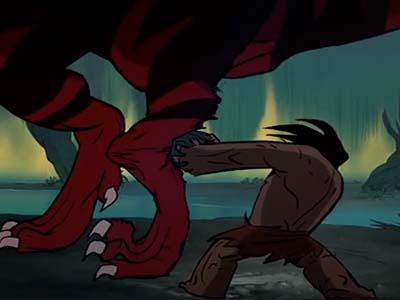
In Breakdown 06, however, the Perspective Turn enhances the wild swinging motion of the character and contributes to the weight of the impact at the end of the action. The Perspective Turn in Breakdown 06 melds with the movements of the character while the one in Breakdown 01 dominates the scene and reinforces the lifelessness of the still figure. Clearly this technique works best when it is used in a contextual way, and not just as an attempt to impress.
More members mean we can bring you more special downloads.
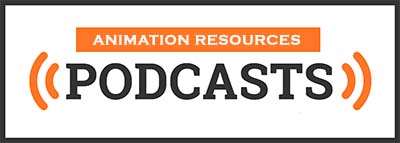
Animation Resources has embarked on a podcasting series with informal screenings, interviews and seminars. Check back to this page regularly for the latest episodes.
Download this article
Is Reference Constructive Or A Crutch?![]()
Animated Discussions 007 / Hosted by Davey Jarrell with Taber Dunipace and Stephen Worth

![]() There’s a myth that says that true artists don’t use reference, that they are just born gifted, and their inspiration just comes out of thin air. This couldn’t be further from the truth. The most successful artists use reference for two main purposes: one is for finding solutions to technical problems, and the other is for general inspiration. Great artists expose themselves to as wide a variety of work as they can, regardless of whether or not they see an immediate practical use for it. In this episode of Animated Discussions, Animation Resources Programming Director Davey Jarrell interviews Board Member Taber Dunipace and President Stephen Worth on how to use reference for both practical purposes and for feeding your creative spirit.
There’s a myth that says that true artists don’t use reference, that they are just born gifted, and their inspiration just comes out of thin air. This couldn’t be further from the truth. The most successful artists use reference for two main purposes: one is for finding solutions to technical problems, and the other is for general inspiration. Great artists expose themselves to as wide a variety of work as they can, regardless of whether or not they see an immediate practical use for it. In this episode of Animated Discussions, Animation Resources Programming Director Davey Jarrell interviews Board Member Taber Dunipace and President Stephen Worth on how to use reference for both practical purposes and for feeding your creative spirit.
MP3 Audio File / 1:33:32 / 57 MB Download
Using Live Action Reference![]()
Animated Discussions 006 / Hosted by Davey Jarrell with Stephen Worth
All animators are inspired by animation. But how many are inspired by live action? While there’s a seemingly infinite variety of styles in live action, animation tends to stick to the same few kinds of films. In this new episode of Animated Discussions, Director of Programming Davey Jarrell and President Stephen Worth discuss the ways in which live action can be used as an influence to create new kinds of animation.
MP3 Audio File / 1:08:27 / 131 MB Download
DOCUMENTARY: Visions Of Light
MP4 Video File / 1:30:00 / 1.07 GB Download
ARTICLE: Cinematography For Animators
Advice From An Educator![]()
Animated Discussions 005 / Hosted by Davey Jarrell with Taber Dunipace
Do you ever wonder what your animation teachers are thinking? Taber Dunipace is an educator who is willing to speak frankly about what works and what doesn’t for students looking to become an animation artist. We were lucky enough to be able interview Taber recently about the biggest misconceptions students have about the industry, how to make the most out of your education, and the transition from being a student to professional. His advice is invaluable. In this episode of Animated Discussions, Animation Resources Director of Programming Davey Jarrell is joined by animation educator and Animation Resources Board member Taber Dunipace.
MP3 Audio File / 1:12:19 / 80 MB Download
Joe Murray Interview![]()
Animated Discussions 004 / Hosted by Davey Jarrell
Joe Murray is the creator and producer of the TV shows Rocko’s Modern Life, Camp Lazlo, and Let’s Go Luna!, and is the author of the book Creating Animated Cartoons with Character. He has also worked many years as an independent animator and children’s book illustrator. Even when working for big studios, all of his shows maintain his signature style and unique worldview. Find out what inspires Joe, how he creates characters, and who his biggest influences are this episode of Animated Discussions.
MP3 Audio File / 49:39 / 72 MB Download
Different Artists, Different Paths![]()
Animated Discussions 003 / Davey Jarrell & Stephen Worth
There are as many different paths to success as there are different artists. How does a young artist go about charting a course to find his own way in the artistic world? That is the subject of the third podcast in our “Animated Discussions” series. Animation Resources’ Director of Programming Davey Jarrell and President Stephen Worth are the hosts.
MP3 Audio File / 1:11:31 / 137 MB Download
Previous Podcasts
As a thank you to our annual members, Animation Resources maintains an archive of our past podcasts on the Annual Member Bonus Archive. Here, you will find:
Animated Discussions 002: Chuck Jones Bar Sheets
Animated Discussions 001: Slapstick Analysis: The Saw Mill
Video Seminar 001: Background Layouts by Nestor Redondo
Animation Interview 001: Andrew Chesworth
Lesson 001: Warming Up Exercises
Archive 001: About Our Archive Database
Book Look 001: Taschen’s Disney Archive
Available to Student and General Members
If you are currently on a quarterly membership plan, consider upgrading to an annual membership to get access to our bonus page with even more downloads. If you still have time on you quarterly membership when you upgrade to an annual membership, email us at…
membership@animationresources.org
…and we will credit your membership with the additional time.
It’s Members Appreciation Time again at Animation Resources, and for the next 30 days we will be sharing reasons why you should be a member of our important project. For more information on the benefits of membership, see the Member Appreciation Page. It’s easy to join. Just click on this link and you can sign up right now online…
JOIN TODAY!
https://animationresources.org/membership/levels/
![]()
![]() Animation Resources depends on your contributions to support its projects. Even if you can’t afford to join our group right now, please click the button below to donate whatever you can afford using PayPal.
Animation Resources depends on your contributions to support its projects. Even if you can’t afford to join our group right now, please click the button below to donate whatever you can afford using PayPal.


















